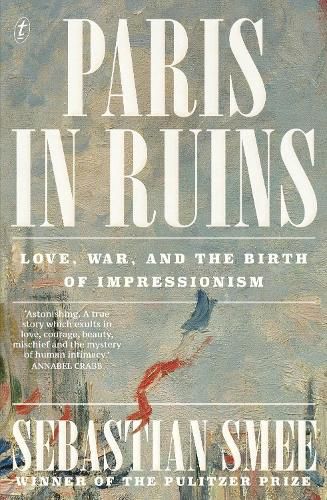Readings Newsletter
Become a Readings Member to make your shopping experience even easier.
Sign in or sign up for free!
You’re not far away from qualifying for FREE standard shipping within Australia
You’ve qualified for FREE standard shipping within Australia
The cart is loading…






The Pulitzer Prize-winning art critic's gripping account of how political turmoil in Paris from 1870-1871 gave rise to Impressionism.
Impressionism-its dramatic depiction of light, its lovely evocation of the transience of everything-remains wildly popular. Crowds flock to exhibitions by its greatest artists-Edouard Manet, Berthe Morisot, Pierre-Auguste Renoir, Edgar Degas, Claude Monet, Camille Pissarro. But as Sebastian Smee shows in Paris in Ruins, a book of great narrative sweep and vivid detail, Impressionism was a complex reaction to an age of violence, civil war, and political intrigue.
From the summer of 1870 to the spring of 1871, famously dubbed the 'Terrible Year', Paris and its people were cut off, starved, and forced to surrender by Germans-before rebel republicans established a breakaway government or Commune. After street fighting and the burning of central Paris, the republicans were crushed by the French army.
In Paris in Ruins Smee tells this story through the eyes of these key artists, with a special focus on the intimate, enigmatic relationship between Manet-the father of Impressionism-and Morisot, the group's only female member in its early years. An indelible portrait of the city, Paris in Ruins captures the shifting passions and politics of the art world, and reveals how the chaos of that year had an incalculable effect on the development of modern art.
$9.00 standard shipping within Australia
FREE standard shipping within Australia for orders over $100.00
Express & International shipping calculated at checkout
The Pulitzer Prize-winning art critic's gripping account of how political turmoil in Paris from 1870-1871 gave rise to Impressionism.
Impressionism-its dramatic depiction of light, its lovely evocation of the transience of everything-remains wildly popular. Crowds flock to exhibitions by its greatest artists-Edouard Manet, Berthe Morisot, Pierre-Auguste Renoir, Edgar Degas, Claude Monet, Camille Pissarro. But as Sebastian Smee shows in Paris in Ruins, a book of great narrative sweep and vivid detail, Impressionism was a complex reaction to an age of violence, civil war, and political intrigue.
From the summer of 1870 to the spring of 1871, famously dubbed the 'Terrible Year', Paris and its people were cut off, starved, and forced to surrender by Germans-before rebel republicans established a breakaway government or Commune. After street fighting and the burning of central Paris, the republicans were crushed by the French army.
In Paris in Ruins Smee tells this story through the eyes of these key artists, with a special focus on the intimate, enigmatic relationship between Manet-the father of Impressionism-and Morisot, the group's only female member in its early years. An indelible portrait of the city, Paris in Ruins captures the shifting passions and politics of the art world, and reveals how the chaos of that year had an incalculable effect on the development of modern art.
Pulitzer Prize-winning writer Sebastian Smee is renowned for his vibrant portrayal of art history. Unlike some authors, who deliver the past with the enthusiasm of a bored Year 8 teacher, Smee brings events to life vividly, with remarkable energy and insight.
His latest book, Paris in Ruins, tells the story of the Impressionist movement as it wriggled into existence during the incredible political volatility, and then urban gentrification, of 19th-century Paris.
Smee skilfully uncovers the era’s complexities through the intricacies of its human relationships. Focusing on figures such as Édouard Manet and, refreshingly, the often-overlooked Berthe Morisot, as their lives unfold in the lead-up to the devastating Siege of Paris in 1870 and the subsequent Republican rebellion.
I found this book both devastating and entertaining to read. Occasionally, it is reminiscent of an Alexandre Dumas novel, with a cast of people who find themselves in awkward and ridiculous situations – crashing double-decker hot-air balloons into villages or getting into duels, for example. Matters of the heart are also navigated, in situations fraught with social rules. The book illuminates the interactions and rivalries between Morisot, Édouard Manet, his brother Eugène, and the moody Edgar Degas, using sections of commentary from diaries and letters that left me expelling air they were so barbed. Morisot was the origin of many of these moments, relaying events from Paris in letters to her sister.
I felt a deep empathy for the women of this period, particularly those in the lower classes, who were largely trapped in Paris before the ‘Terrible Year’ set in. Reflecting on how I would have fared if I were in their place was unsettling and thought-provoking. There are also moments within this work that seem to mirror some of the events we have seen more recently in our own time, and this raucous, layered and engrossing read left me reminded of the inseparable bond between politics and art.
Discover our latest new release fiction and nonfiction books.
Delve into visual art, fashion, architecture and design with these beautiful new releases, available at Readings.